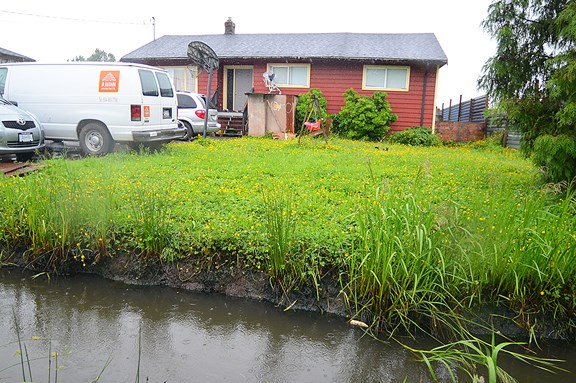After a two-year-old girl drowned in a ditch last week, a Queensborough mother is calling on the City of New Westminster to fill all ditches in the neighbourhood immediately.
Josephreen Luk wants to see 500 people sign her petition before she presents it to city council. (At press time, it had 220 signatures.)
“These ditches should have been filled a long time ago,” she told the Record.
Luk has lived in Queensborough for three years. She has two small children and is always on alert whenever the kids are outside, she said.
“They haven’t fallen in, but I’m watchful every day,” she said, adding her neighbour’s toddler fell in and had to be rescued.
Luk wants the city to fill the ditches like they’ve done on Ewen Avenue. She said the current situation has gone on long enough.
“I think this happens more often than people realize; it’s just not everyone gets reported, and unfortunately, the last one ended up in a really tragic event,” she said, “and her life was priceless.”
Two-year-old Biftu Taju died on June 7 after falling into a ditchoutside her home on Stanley Street, a small road off Ewen Avenue in the eastern part of Queensborough. Like other older parts of the ’Boro, Stanley Street is lined with water-filled ditches.
According to family friend Amin Jundi, the ditches are “absolutely a problem.”
“Raising small children in this kind of environment … it doesn’t look good,” he told reporters last week.
But the City of New Westminster has not received any safety complaints about the ditches in the ’Boro, according to director of engineering Jim Lowrie.
Efforts are underway to fill some of the neighbourhood’s ditches, but there are only two ways to proceed.
Private residents can petition the city through the local area improvement program, a method of funding local infrastructure projects that benefit specific properties. (The Community Charter requires support from at least 50 per cent of property owners in the local service area. If the request is approved by the city, the property owners would be billed for half the cost of the infill.)
But ditches are more likely to be filled in by developers, who are required by bylaw to install storm sewers in new developments.
“It’s an area in transition that’s going from suburban to more urbanized land-use form, so as development occurs, we require developers to install storm sewer systems and sidewalks and street lights, and all of the urban requirements,” Lowrie said.
When asked if the city would ever consider filling the open ditches, Lowrie said the cost would likely be too great. But how much exactly it would cost is impossible to say because there are so many factors that would go into such a proposal, he said.
“We look at each street individually, and we have to design and engineer a system appropriate for that street, so the cost can fluctuate quite a bit,” he added.
If such a proposition did move forward, it would be a long-term project, and property owners would be expected to pay for half of the costs under the city’s local area improvement program. That said, any petition that is brought before council would be given due consideration, Lowrie said.
Click here to read the petition.
What do ditches do?
Because Queensborough is on the floodplain, ditches are needed to allow water to move freely so homes and businesses don’t flood.
The majority of ditches are there to protect against flooding, but some of the ditches are also wildlife habitats.
In the 1960s, a perimeter dyke was built on Queensborough, protecting approximately 350 hectares. Water from the dyke area is pumped out and into the Fraser River.
Historically, because Queensborough was a farming area made up of large acreages, ditches provided the most cost-effective drainage solution. Drainage remains their main purpose today.
As the area changes and development continues, the old ditches are being filled in and replaced with storm sewers connected to the city’s pump stations. If the city were to fill all the ditches at once, major work would have to be done at the four pump stations to increase capacity to avoid flooding.
– Source: City of New Westminster and engineering director Jim Lowrie



